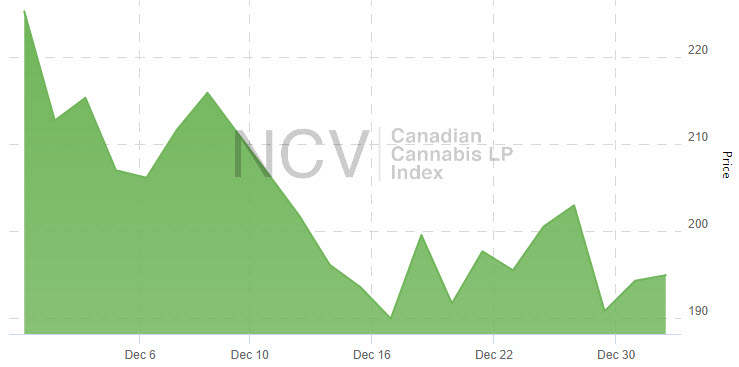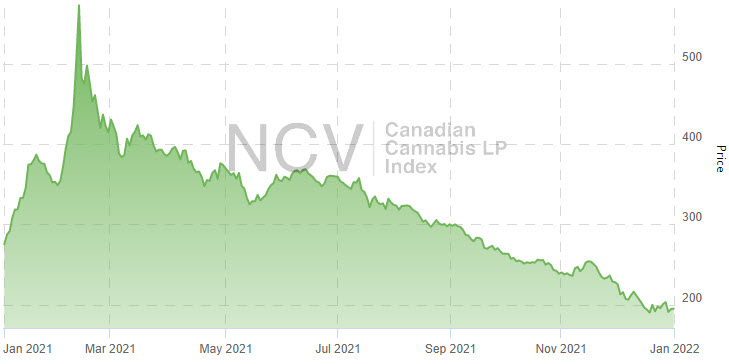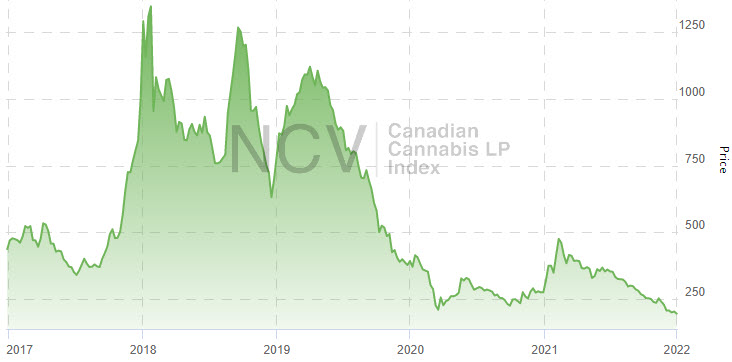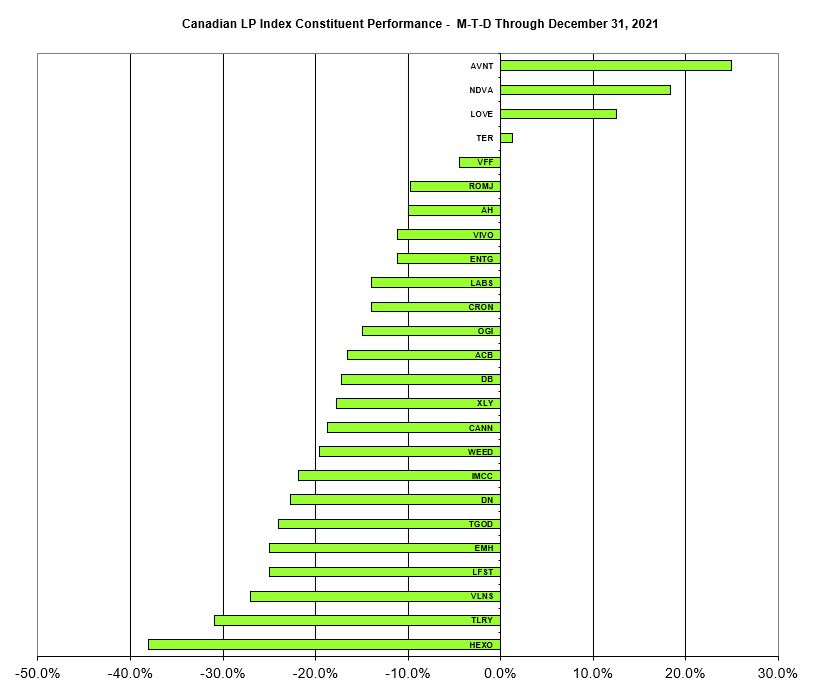Canadian Cannabis Stocks Cap Challenging Year With 13% Decline in December
FeaturedTrending Stories January 2, 2022 MJ Shareholders 0
After retreating almost 27% in Q3, the Canadian Cannabis LP Index extended its losing streak to six months as it fell again in December, declining 13.5% to 194.95:
 The index, which fell 30.1% in 2020 to end at 275.16, fell 26.0% in Q4 and 29.2% for all of 2021:
The index, which fell 30.1% in 2020 to end at 275.16, fell 26.0% in Q4 and 29.2% for all of 2021:
 It remains substantially below the all-time closing high of 1314.33 in September 2018, just ahead of Canadian adult-use legalization. In March 2020, it posted a new multi-year closing low of 196.10, a level that had not been seen since late 2016, and it closed 0.6% below that level this month:
It remains substantially below the all-time closing high of 1314.33 in September 2018, just ahead of Canadian adult-use legalization. In March 2020, it posted a new multi-year closing low of 196.10, a level that had not been seen since late 2016, and it closed 0.6% below that level this month:

The Canadian Cannabis LP Index, which is rebalanced monthly, included 25 qualifying publicly traded licensed producers that traded in Canada at the end of October, with equal weighting for each stock. Each of the members was also included in a sub-index, with 5 in the Canadian Cannabis LP Tier 1 Index, 8 in the Canadian Cannabis LP Tier 2 Index and 12 in the Canadian Cannabis LP Tier 3 Index during the month. At the end of November 2021, we raised the minimum for Tier 1 from C$25 million to C$30 million, for Tier 2 from C$5 million to C$7.5 million and for Tier 3 to C$2.5 million from zero. This was the first change since June 2020, when we required companies to have a price of at least C$0.20 unless they are generating at least C$2.5 million quarterly from their cannabis production operation. Previously, we required revenue in excess of C$1 million for stocks trading below C$0.20. There are currently more than two dozen publicly traded LPs that fail to qualify.
Tier 1
Tier 1, which included the LPs that are generating cannabis-related sales of at least C$30 million per quarter, fell 5.1% to 402.42 in December. Tier 1, which dropped 23.9% in 2020 when it ended at 488.96, declined 17.7% in 2021. We have increased the minimum revenue required to be included over time. In November 2021, we raised it from C$25 million. At the beginning of 2021, we raised it from C$20 million. During 2019 and the first half of 2020, companies needed to generate revenue in excess of C$10 million for inclusion. In 2018, we used C$4 million as the hurdle.
This group included Aurora Cannabis (TSX: ACB) (NASDAQ: ACB), Canopy Growth (TSX: WEED) (NASDAQ: CGC), HEXO Corp (TSX: HEXO) (NASDAQ: HEXO), Tilray (TSX: TLRY) (NASDAQ: TLRY) and Village Farms (TSX: VFF) (NASDAQ: VFF).
Among these largest LPs by revenue, HEXO was the worst performer, falling 38%, followed by Tilray’s decline of 31%. The best performing company was Village Farms, which fell 4.5%.
Tier 2
Tier 2, which included the LPs that generate cannabis-related quarterly sales between C$7.5 million and C$30 million, fell 15.0% to 302.79. In 2020, it lost 35.9% in 2020, closing at 365.19, and it was down 17.1% in 2021. Prior to December 2021, companies needed revenue in excess of C$5 million to qualify for inclusion. Prior to July 2020, companies needed revenue in excess of C$2.5 million to be included in this tier.
This group included Aleafia Health (TSX: AH) (OTC: ALEAF), Auxly (TSX: XLY) (OTC: CBWTF), Cronos Group (TSX: CRON) (NASDAQ: CRON), Decibel Cannabis (TSXV: DB) (OTC: DBCCF), Entourage Health (TSXV: ENTG) (OTC: ETRGF), Indiva (TSXV: NDVA) (OTC: NDVAF) Organigram (TSX: OGI) (NASDAQ: OGI) and Valens Company (TSX: VLNS) (NASDAQ: VLNS).
Among these companies, Valens saw the largest decline, 27%, while Indiva had the largest gain, 18%.
Tier 3
Tier 3, which included the 12 qualifying LPs that generate cannabis-related quarterly sales of C$2.5-C$7.5 million, rose 0.4% as it closed at 53.35. It ended at 66.59 in 2020, declining 31.2%, and was down 19.9% in 2021. The worst performance among this group was from Lifeist Wellness (CSE: LFST) (OTC: NXTTF), formerly Namaste Technologies, which dropped 25%. The best performer was Avant Brands (TSXV: AVNT) (OTC: AVTBF), which rose 25%.
The returns for the overall sector varied greatly, with 3 names posting double-digit gains and 8 declining by more than 20%. The entire group posted a median return of -16.6%:

For January, the overall index will have 24 constituents, as Village Farms has delisted from the TSX.
In the next monthly review, we will summarize the performance for January and discuss any additions or deletions. Be sure to bookmark the pages to stay current on LP stock price movements within the day or from day-to-day.
 Get ahead of the crowd by signing up for 420 Investor, the largest & most comprehensive premium subscription service for cannabis traders and investors since 2013.
Get ahead of the crowd by signing up for 420 Investor, the largest & most comprehensive premium subscription service for cannabis traders and investors since 2013.
Get Our Sunday Newsletter
#mc_embed_signup{background:#fff; clear:left; } /* Add your own MailChimp form style overrides in your site stylesheet or in this style block. We recommend moving this block and the preceding CSS link to the HEAD of your HTML file. */
In This Article:
ACB, AH, aleaf, Aleafia, Aurora Cannabis, auxly, avant Brands, avnt, avtbf, Canopy Growth, cbwtf, CGC, CRON, Cronos Group, db, dbccf, decibel cannabis, entg, entourage health, etrgf, Hexo, hexo corp, INDIVA, lfst, lifeist, NDVA, ndvaf, NXTTF, OGI, Organigram, Tilray, TLRY, Valens, VFF, Village Farms, vlns, WEED, xly
Related News:
Global Cannabis Stock Index Slides 10th Consecutive Month to End 2021 Down 26%
These Key Canadian Cannabis Companies Will Be Reporting Financials in January
Constellation Brands Has Gone From FOMO to Frustration With Its Canopy Growth Investment
LiUNA Pension Fund to Lend Entourage Health Additional $20 Million
MJ Shareholders
MJShareholders.com is the largest dedicated financial network and leading corporate communications firm serving the legal cannabis industry. Our network aims to connect public marijuana companies with these focused cannabis audiences across the US and Canada that are critical for growth: Short and long term cannabis investors Active funding sources Mainstream media Business leaders Cannabis consumers










No comments so far.
Be first to leave comment below.